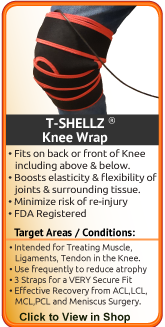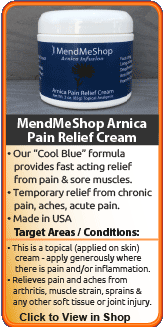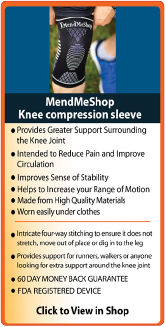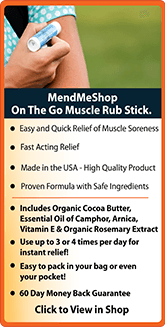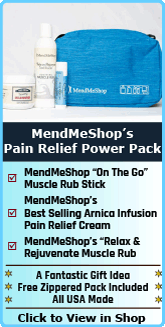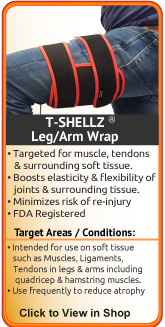Patellar Chondromalacia -
Runner's Knee - Patellofemoral Pain Syndrome
The knee may seem like a simple joint in the body but it is very complex. The kneecap acts as shock absorber (the cartilage on the underside), a lever for your leg and as protection for your joint. The kneecap glides smoothly over the surrounding tissue and bones as you straighten your knee.
Patellar chondromalacia, is the softening and breakdown of the underside cartilage of the kneecap. This breakdown continues the cartilage tissue may cause it to crack, blister or shred into a mass of fibers. In severe cases the degeneration is complete and the cartilage is gone, the exposed bony surface of the kneecap will painfully grind against the other bones in the knee. This condition is also known as "Runner's Knee" or Patellofemoral Pain Syndrome.
What are the symptoms of Chondromalacia
Much like arthritis that affects that cartilage of the bones you may have a dull, aching pain most often felt behind, below and on the sides of the kneecap. The pain often increases when using stairs, deep knee bends, squats, running up hill, jumping, getting out of a chair or when participating in activities that put weight on the knee.
You may feel grinding or grating occurs when trying to straighten the knee. The feeling of having your knee 'catching' or as if it may give-way and buckle under you may be experienced. Swelling may also occur along with the pain and inflammation in the knee joint. If these symptoms become chronic, weakened quadriceps muscles may allow the leg to give out which can cause further injury to the knee or leg.
What causes of Chondromalacia
The degeneration of cartilage, leading to chondromalacia resulting irritation, can be caused from many types of joint injures and disorders.
- Poorly aligned bones near the knee joint, such as knock-knee or bowed legs.
- Misalignment of the kneecap from an unbalanced in muscle strength or overpronation (when feet rotate inward). When functioning normally, the quadriceps (thigh) muscles pull the kneecap over the end of the femur in a straight line.
- Trauma to the kneecap, such as break (fracture) or dislocation of the kneecap.
- Overuse of the knee joint, runner's knee can due to repetitive knee rotations while biking, many cyclists experience chondromalacia resulting in chronic knee pain, usually located below the kneecap. Repeated bending or twisting of the knee joint.
- Infection in the knee joint.
- Rheumatoid arthritis or osteoarthritis
- Repeated steroid shots into the knee. You will typically be limited to a maximum treatment of 4 shots to the same area of your body. The benefits are known to reduce after each injection that you have because your body gets used to the synthetic solution.
Who is at Risk?
Chondromalacia is a condition often suffered by young athletes who perform repetitive knee movements such as cycling, running, or jumping. Knock-kneed individuals and flat-footed runners are at greatest risk as these conditions cause the patella to align toward the outer (lateral) side of the femur. As well, a larger percentage of women suffer from patellar chondromalacia due to anatomical differences between men and women that cause women to experience increased lateral forces on the kneecap.
Runners Knee Treatments at Home -
What You Can Do!
It's generally understood by doctors and surgeons, that surgery will introduce more scar tissue into the soft tissue of the knee. This added scar tissue will be problematic, requiring visits to the physio clinic and conservative treatment options post-surgery. This is why surgery is only performed as a last resort for chronic tendonitis injuries that won't heal with conservative treatment methods.
Some conservative treatment methods recommended include:
- Rest - This is important for initial healing because without an correct amount of rest you are at risk for increased inflammation, pain or injury to the soft tissue of the knee joint.
- Cold Compression - Immediate cold compression (using an Cold Compress or Ice Pack) will allow you to manage pain while getting rid of swelling, inflammation and edema in your knee.
- Circulation Boost (via use of the Knee TShellz Wrap®) - You can use your own blood flow to maximize your bodys natural healing process, enhance knee flexibility, and reduce risk of reinjury.
Using a simple conservative treatment such as cold compression to treat your knee injury will reduce swelling to "open up" the area for more blood flow. It will also slow nerve and tissue function in the knee (and reduce pain). This is important because once blood vessels are damaged, they can no longer carry oxygenated blood to the meniscus and tissues begin to break-down.
Anyone in the health-care business knows that your blood supplies the oxygen and much needed nutrients required to heal any soft tissue injuries. This is why for years doctors, trainers and other medical professional have recommended RICE (Rest, Ice, Compression, Elevation) to treat the pain and swelling of fresh injuries, chronic pain, and after any re-injury.
The TShellz® Circulatory Boost Wrap
Once inflammation and swelling has been alleviated, nourishing and strengthening the muscle tissue around the knee joint and in the upper leg is recommended to realign the patella or strenthen the tendons and muscles surrounding the patella. Circulation Boost, via use of the Knee TShellz Wrap® will increase blood flow in your leg while helping improve the flexibility of soft tissue.
When you stop moving your knee because it hurts the amount of blood that flows naturally to your knee joint is reduced, limiting your body's natural ability to heal itself.
Circulatory Boost (via use of the Knee TShellz Wrap®) compliments your body's natural healing process by promoting blood flow while you give your knee the rest it needs. Energy emitted from the Energy Pad stimulates blood flow to your knee, more than your body would ever be able to generate on it's own, giving your body the boost it needs to continue the reconditioning process. This enhanced blood flow helps speed tissue repair, whisk away toxins and dead tissue, and rejuvenates soft tissue for improved elasticity. Circulatory Boost enhances your body's own healing process by simply increasing the amount of blood that flows to your leg and knee to improve the health of your tissue by delivering an abundance of nutrients to the area.
In addition, improved blood flow helps reduce the risk of atrophy in your muscles. When you stop moving your leg and knee due to pain, your muscles and other tissue can become weaker and dead tissue and toxins in the area can cause further tissue deterioration - this can lead to atrophy (muscle weakness and/or deterioration) in your quadriceps, hamstrings and other leg muscles. The Knee TShellz Wrap® is an amazing tool that can be used to help combat this problem.
By clearing the area of toxins and increasing the amount of oxygen and nutrients to your IT band, leg muscles, and knee the risk of atrophy is greatly reduced. Keeping your knee and leg tissue as healthy as possible throughout the healing process will allow you to improve strength again once your pain has gone and your knee has healed.
Slowing down knee degeneration can be helped by avoiding impact exercises and movement that irritates the patella until muscle strength increases. Selective exercises that strengthen the inner quadriceps muscles are recommended to straighten movement of the patella over the femur.
During your recovery, you will probably have to modify and/or eliminate any activities that cause pain or discomfort in your knee area until your pain and inflammation settle. With these easy-to-use therapies, you will notice incredible improvement in your knee condition and pain. The more diligent you are with your treatment and rehabilitation, the faster you will see successful results and the sooner you can return to the activities you enjoy - without pain!
Learn More About These SUPERIOR Knee Treatments
The feedback we have received from so many people who have used our treatment options as part of their healing therapy has been overwhelmingly positive. It can take a comprehensive approach when dealing with serious pain and discomfort...and the TShellz Wrap® and Cold Compress or Ice Pack certainly play critical roles in this aspect.
If you're tired of being told that resting, drugs and surgery are the only answers to your knee pain...Be optimistic, because there are effective alternatives for you.
Product Advisors are available 9:00 am to 5:00 pm Eastern Standard Time Monday to Friday.
Learn More About Knee Injuries & TreatmentsI want to learn more about post-surgery recovery. I want to learn all about common causes of knee pain. I want to learn more about TShellz Wrap® Circulatory Boost I want to learn more about Ice & Heat: Which Is Better For Treatment? I want to learn more about Knee Treatments. I want to learn more about Runners Knee. I want to learn more about Hoffas Syndrome. I want to learn more about Knee Arthritis. I want to learn more about Knee Trigger Points.
FREE SHIPPING ON ALL PRODUCTS CURRENTLY ENABLED
60 DAY TRIAL PERIOD
During your recovery, you will probably have to modify and/or eliminate any activities that cause pain or discomfort at the location of your soft tissue injury until the pain and inflammation settle. The more diligent you are with your treatment and rehabilitation, the faster you will see successful results!
| 
